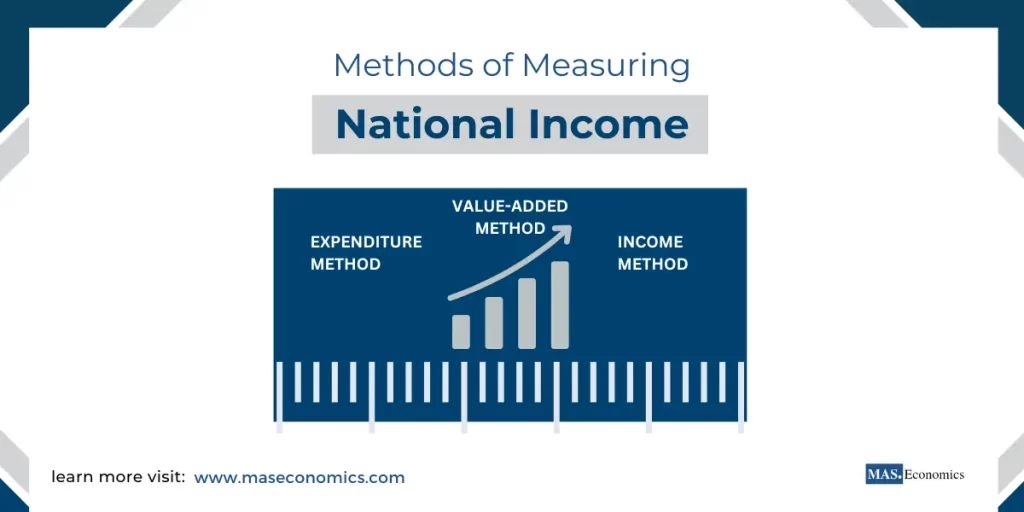National income is a critical concept in macroeconomics, often used to gauge an economy’s overall health. It reflects the total value of all goods and services a country produces within a specific period, typically one year. By understanding national income, policymakers, businesses, and individuals can make informed decisions about economic strategies, investments, and policies. Measuring national income is fundamental for evaluating a country’s progress and comparing economic performance over time and across borders.
However, calculating national income is not as simple as adding numbers—it’s a complex process requiring precision, appropriate methods, and thoughtful adjustments. It involves deciding how to categorize different forms of income, dealing with hidden economic activities, and ensuring that all calculations are consistent. In this article, we will take you through the methods of measuring national income, compare different approaches, and explore the challenges that often come into play.
To make things easier, consider national income as the sum of everyone’s economic contributions—whether it’s an employee’s wages, a company’s profits, or a farmer’s production. Let’s dive deeper into the different ways economists measure this vital statistic.
What is National Income?
National income is the total value of income earned by residents of a country through productive activities. It includes wages, interest, rent, and profits—essentially any form of income that contributes to the economy. National income provides a comprehensive picture of economic activity, highlighting the value produced domestically and earnings from investments abroad.
To provide some context, economists have different perspectives on what drives national income. From the Keynesian perspective, national income is influenced by aggregate demand—the total demand for goods and services within the economy. Keynesians advocate for the role of government spending and policies to regulate demand, especially during economic downturns. On the other hand, classical economists argue that supply factors, like the availability of labor and capital, drive national income. They believe that markets naturally adjust to achieve equilibrium without much government intervention.
Now that we understand national income better, let’s look at the three primary methods used to measure it: the product (or value-added), revenue, and expenditure.
Methods of Measuring National Income
Each of the three main measures of national income offers unique insights into a country’s economic performance. These approaches allow us to calculate national income by focusing on different aspects of the economy, such as production, income generation, and spending patterns.
Product or Value-Added Method
The product or value-added method measures national income by calculating the value added at each production stage. Imagine you’re following a product from the time raw materials are harvested to the point where it reaches the consumer. By calculating the “value added” at each stage, we can determine the contribution of different producers without counting the same value more than once.
To help illustrate, let’s walk through a simple example of how bread is produced:
- A farmer sells wheat to a miller for $50.
- The miller then processes the wheat into flour and sells it to a bakery for $80.
- Finally, the bakery uses the flour to make bread, which it sells to consumers for $120.
Now, let’s break down the value added at each step:
- The farmer contributes $50 by growing and selling the wheat.
- The miller contributes $30 by processing the wheat into flour, which is calculated as $80 (selling price)—$50 (cost of wheat).
- The bakery adds another $40 by baking and selling the bread, calculated as $120 (selling price)—$80 (cost of flour).
So, the total value added is $50 + $30 + $40 = $120, representing the bread’s final value.
The formula used to calculate national income using the value-added method is:
\( \text{GDP}_{\text{Market Price}} = \Sigma (\text{Value Added at Each Stage of Production}) \)
This formula tells us that GDP is calculated by adding up all the value added at each stage of production across all sectors of the economy.
Advantages of the Product Method
The value-added method is particularly effective because it helps to avoid double counting, a common issue when intermediate goods are counted multiple times. By focusing on the value added at each step, we ensure that only the contribution of each producer is included in the national income.
Challenges of the Product Method
However, this method does have its challenges. It can be difficult to account for the informal economy, especially in developing nations where many transactions are not officially recorded. Additionally, gathering detailed data for every production process is often impractical, which can limit the method’s accuracy.
Income Method
The income method focuses on the income generated by all factors of production in an economy, such as wages for labor, rents for land, interest for capital, and profits for entrepreneurship. This method provides insights into how income is distributed among the different sectors of the economy.
Imagine an economy with the following income distribution:
- Wages paid to workers amount to $500 million.
- Rents earned from leasing properties add up to $100 million.
- Interest earned from savings and investments totals $80 million.
- Business profits are $300 million.
To calculate the national income, we add these components together:
\( \text{National Income} = W + R + I + P \)
\( \text{National Income} = 500 + 100 + 80 + 300 = 980 \, \text{million dollars} \)
Where:
- \( W \) represents wages and salaries,
- \( R \) represents rental income,
- \( I \) represents interest income,
- \( P \) represents profits.
Advantages of the Income Method
This method is beneficial for understanding the contribution of labor and capital to the economy. It gives us a picture of how wealth is generated, making it easier to analyze income inequality or assess economic sectors.
Challenges of the Income Method
One of the main challenges of this method is that it can be difficult to capture informal earnings—for example, income from cash-based transactions or self-employment. Additionally, distinguishing between different types of income can be complex, especially for people who derive their income from multiple sources.
Expenditure Method
The expenditure method takes a different approach. It measures national income by calculating the total expenditure on final goods and services in the economy. This method assumes that all the income earned within an economy will eventually be spent on consumption, investment, government purchases, or net exports.
The components of the expenditure method are:
Consumption (C): Households spend on goods and services, like groceries or rent.
Investment (I): Spending by businesses on capital goods, like new equipment or construction of factories.
Government Spending (G): Spending by the government on public services, including healthcare, education, and infrastructure.
Net Exports (X – M): The value of exports minus imports. This measures the contribution of international trade to national income.
Let’s consider an example where:
- Consumption by households is $1 trillion.
- Investment by businesses is $300 billion.
- Government spending is $500 billion.
- Net exports amount to -$30 billion (indicating that the country imports more than it exports).
Using the expenditure method, we calculate:
\( \text{GDP}_{\text{Market Price}} = C + I + G + (X – M) \)
\( \text{GDP} = 1 \, \text{trillion} + 300 \, \text{billion} + 500 \, \text{billion} – 30 \, \text{billion} = 1.77 \, \text{trillion dollars} \)
Advantages of the Expenditure Method
The expenditure method aligns closely with Keynesian economics, which emphasizes the importance of aggregate demand. By examining how much is spent in the economy, it provides insights into what drives growth—whether it is consumer spending, government policies, or business investments.
Challenges of the Expenditure Method
Despite its usefulness, the expenditure method faces certain limitations. For example, it can underestimate the informal sector, where transactions must be reported more. Additionally, fluctuations in net exports—which can be influenced by international economic conditions—may cause discrepancies when comparing different economies.
Comparisons of National Income
When measuring national income, it’s essential to understand how much income is produced and how that income changes over time or compares to other countries.
Inter-Temporal Comparisons
Inter-temporal comparisons help track national income over different periods to assess economic growth and improvements in living standards. To make accurate comparisons over time, economists use real GDP, which adjusts for inflation. Using real GDP, we can determine whether an increase in national income is due to actual growth or simply rising prices.
In addition, per capita GDP—which divides national income by the population—provides insights into changes in living standards. Rapid population growth, for instance, can reduce per capita GDP even if overall GDP is growing, indicating that the average standard of living may not improve.
International Comparisons
International comparisons of national income require adjustments for factors like currency exchange rates and purchasing power parity (PPP). PPP adjusts income figures to reflect differences in the cost of living across countries, providing a more accurate picture of economic well-being. For instance, $1 can buy significantly more in some developing countries than in developed nations, and PPP helps adjust for these differences.
Challenges in Measuring National Income
Despite its importance, measuring national income is challenging. Let’s explore some of the key obstacles.
Double Counting
Double counting is one of the most common issues, where intermediate goods are counted multiple times, inflating GDP figures. For instance, if wheat and the bread made from it are counted, the resulting GDP value would be artificially high. The value-added method helps address this problem by ensuring that only the additional value at each stage is included.
Informal Economy and Unreported Income
A significant part of economic activity occurs in the informal sector, particularly in developing countries. Transactions in these sectors must be officially recorded, leading to an underestimation of national income. This makes it challenging for policymakers to understand economic performance accurately.
Non-Market Activities
National income calculations also exclude non-market activities like household chores or volunteer work. While these activities contribute significantly to well-being, they are often excluded because there is no formal transaction or clear market value. Estimating the value of such activities could provide a more complete picture of economic output, but this remains a methodological challenge.
Environmental Costs
Traditional measures of national income do not account for environmental costs such as resource depletion or pollution. As the world becomes more aware of sustainability, there is a growing need for metrics like Green GDP, which adjusts for environmental degradation to give a more holistic picture of economic health.
Conclusion
Measuring national income is a complex yet essential task that provides a snapshot of an economy’s health. The product, income, and expenditure methods bring valuable perspectives, helping us understand how wealth is produced and distributed. We can gain insights into economic growth, development, and global standing by comparing national income over time or across countries.
While each method has its strengths, challenges like double counting, informal activities, and unaccounted environmental costs must be addressed to ensure that national income statistics accurately reflect reality.
FAQs:
What is national income, and why is it important?
National income is the total value of all goods and services produced within a country during a specific period, often one year. It reflects the income generated by residents from productive activities, including wages, rents, interest, and profits. National income helps assess economic health, track growth, guide policymaking, and compare economic performance over time or across countries.
What are the main methods of measuring national income?
National income is typically measured using three methods:
- Product or Value-Added Method: Focuses on the value added at each stage of production across all sectors. This method ensures intermediate goods are not counted multiple times.
- Income Method: Adds up the income earned by factors of production, such as wages, rents, interest, and profits.
- Expenditure Method: Measures the total spending on final goods and services, including consumption, investment, government spending, and net exports.
How does the product or value-added method prevent double counting?
The value-added method ensures that only the additional value created at each production stage is included. For example, if a farmer sells wheat to a bakery, only the additional value contributed by the bakery when converting wheat into bread is counted in GDP, avoiding the issue of counting wheat and bread separately.
What are the challenges of using the income method?
The income method struggles with accurately capturing informal or unreported income, especially in economies with large informal sectors. It can also be challenging to categorize different types of income, particularly when individuals earn from multiple sources, such as salaries, dividends, or rental income.
How does the expenditure method capture national income?
The expenditure method measures national income by calculating total spending on final goods and services. It aggregates household consumption, business investments, government spending, and net exports. This approach aligns with Keynesian economics by emphasizing the role of aggregate demand in driving economic growth.
Why is it challenging to compare national income across countries?
International comparisons of national income require adjustments for currency exchange rates and purchasing power parity (PPP). PPP accounts for differences in the cost of living between countries, offering a more accurate picture of economic well-being than nominal income figures alone.
What is the role of real GDP in inter-temporal comparisons?
Real GDP adjusts for inflation, providing a clearer picture of economic growth over time. It helps distinguish between actual increases in production and mere price rises, allowing economists to evaluate whether living standards are improving.
How do informal activities affect national income calculations?
Informal activities, like cash-based transactions or self-employment, often go unreported and are not captured in official national income figures. This can lead to underestimations, particularly in developing economies where informal sectors play a significant role.
What are some limitations of traditional national income measures?
Traditional measures do not account for non-market activities, such as household work or volunteer services, which contribute to well-being but lack formal transactions. Additionally, they exclude environmental costs, such as resource depletion or pollution, leading to incomplete assessments of economic health.
How can environmental costs be integrated into national income?
Metrics like Green GDP adjust traditional GDP figures to account for environmental degradation and resource depletion. Green GDP offers a more comprehensive view of sustainable economic performance, considering both economic output and environmental impact.
Thanks for reading! Share this with friends and spread the knowledge if you found it helpful.
Happy learning with MASEconomics




